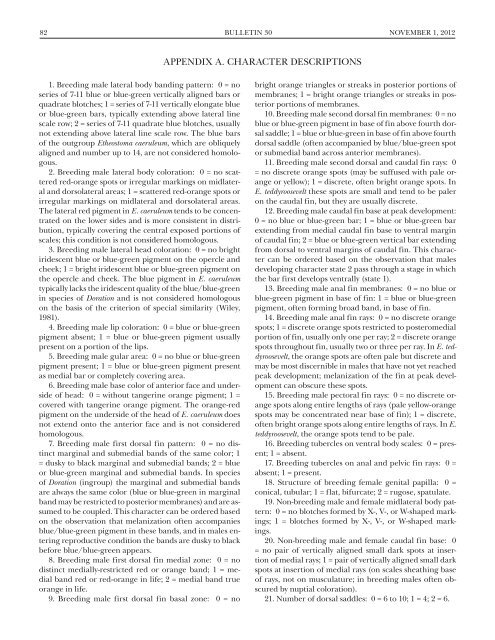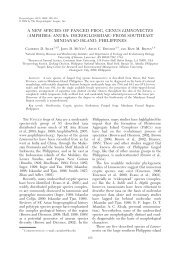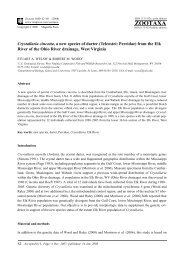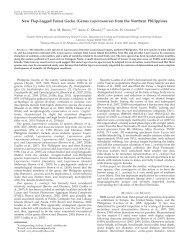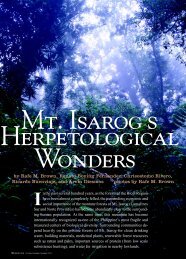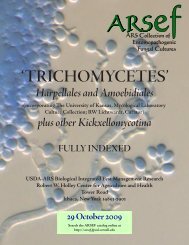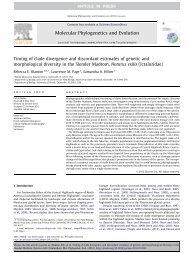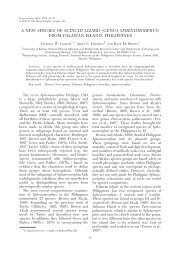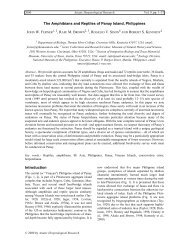(Percidae: Etheostoma), with Descriptions of Five New Species
(Percidae: Etheostoma), with Descriptions of Five New Species
(Percidae: Etheostoma), with Descriptions of Five New Species
- No tags were found...
Create successful ePaper yourself
Turn your PDF publications into a flip-book with our unique Google optimized e-Paper software.
82 Bulletin 30 NOVEMBER 1, 2012APPENDIX A. CHARACTER DESCRIPTIONS1. Breeding male lateral body banding pattern: 0 = noseries <strong>of</strong> 7-11 blue or blue-green vertically aligned bars orquadrate blotches; 1 = series <strong>of</strong> 7-11 vertically elongate blueor blue-green bars, typically extending above lateral linescale row; 2 = series <strong>of</strong> 7-11 quadrate blue blotches, usuallynot extending above lateral line scale row. The blue bars<strong>of</strong> the outgroup <strong>Etheostoma</strong> caeruleum, which are obliquelyaligned and number up to 14, are not considered homologous.2. Breeding male lateral body coloration: 0 = no scatteredred-orange spots or irregular markings on midlateraland dorsolateral areas; 1 = scattered red-orange spots orirregular markings on midlateral and dorsolateral areas.The lateral red pigment in E. caeruleum tends to be concentratedon the lower sides and is more consistent in distribution,typically covering the central exposed portions <strong>of</strong>scales; this condition is not considered homologous.3. Breeding male lateral head coloration: 0 = no brightiridescent blue or blue-green pigment on the opercle andcheek; 1 = bright iridescent blue or blue-green pigment onthe opercle and cheek. The blue pigment in E. caeruleumtypically lacks the iridescent quality <strong>of</strong> the blue/blue-greenin species <strong>of</strong> Doration and is not considered homologouson the basis <strong>of</strong> the criterion <strong>of</strong> special similarity (Wiley,1981).4. Breeding male lip coloration: 0 = blue or blue-greenpigment absent; 1 = blue or blue-green pigment usuallypresent on a portion <strong>of</strong> the lips.5. Breeding male gular area: 0 = no blue or blue-greenpigment present; 1 = blue or blue-green pigment presentas medial bar or completely covering area.6. Breeding male base color <strong>of</strong> anterior face and underside<strong>of</strong> head: 0 = <strong>with</strong>out tangerine orange pigment; 1 =covered <strong>with</strong> tangerine orange pigment. The orange-redpigment on the underside <strong>of</strong> the head <strong>of</strong> E. caeruleum doesnot extend onto the anterior face and is not consideredhomologous.7. Breeding male first dorsal fin pattern: 0 = no distinctmarginal and submedial bands <strong>of</strong> the same color; 1= dusky to black marginal and submedial bands; 2 = blueor blue-green marginal and submedial bands. In species<strong>of</strong> Doration (ingroup) the marginal and submedial bandsare always the same color (blue or blue-green in marginalband may be restricted to posterior membranes) and are assumedto be coupled. This character can be ordered basedon the observation that melanization <strong>of</strong>ten accompaniesblue/blue-green pigment in these bands, and in males enteringreproductive condition the bands are dusky to blackbefore blue/blue-green appears.8. Breeding male first dorsal fin medial zone: 0 = nodistinct medially-restricted red or orange band; 1 = medialband red or red-orange in life; 2 = medial band trueorange in life.9. Breeding male first dorsal fin basal zone: 0 = nobright orange triangles or streaks in posterior portions <strong>of</strong>membranes; 1 = bright orange triangles or streaks in posteriorportions <strong>of</strong> membranes.10. Breeding male second dorsal fin membranes: 0 = noblue or blue-green pigment in base <strong>of</strong> fin above fourth dorsalsaddle; 1 = blue or blue-green in base <strong>of</strong> fin above fourthdorsal saddle (<strong>of</strong>ten accompanied by blue/blue-green spotor submedial band across anterior membranes).11. Breeding male second dorsal and caudal fin rays: 0= no discrete orange spots (may be suffused <strong>with</strong> pale orangeor yellow); 1 = discrete, <strong>of</strong>ten bright orange spots. InE. teddyroosevelt these spots are small and tend to be paleron the caudal fin, but they are usually discrete.12. Breeding male caudal fin base at peak development:0 = no blue or blue-green bar; 1 = blue or blue-green barextending from medial caudal fin base to ventral margin<strong>of</strong> caudal fin; 2 = blue or blue-green vertical bar extendingfrom dorsal to ventral margins <strong>of</strong> caudal fin. This charactercan be ordered based on the observation that malesdeveloping character state 2 pass through a stage in whichthe bar first develops ventrally (state 1).13. Breeding male anal fin membranes: 0 = no blue orblue-green pigment in base <strong>of</strong> fin: 1 = blue or blue-greenpigment, <strong>of</strong>ten forming broad band, in base <strong>of</strong> fin.14. Breeding male anal fin rays: 0 = no discrete orangespots; 1 = discrete orange spots restricted to posteromedialportion <strong>of</strong> fin, usually only one per ray; 2 = discrete orangespots throughout fin, usually two or three per ray. In E. teddyroosevelt,the orange spots are <strong>of</strong>ten pale but discrete andmay be most discernible in males that have not yet reachedpeak development; melanization <strong>of</strong> the fin at peak developmentcan obscure these spots.15. Breeding male pectoral fin rays: 0 = no discrete orangespots along entire lengths <strong>of</strong> rays (pale yellow-orangespots may be concentrated near base <strong>of</strong> fin); 1 = discrete,<strong>of</strong>ten bright orange spots along entire lengths <strong>of</strong> rays. In E.teddyroosevelt, the orange spots tend to be pale.16. Breeding tubercles on ventral body scales: 0 = present;1 = absent.17. Breeding tubercles on anal and pelvic fin rays: 0 =absent; 1 = present.18. Structure <strong>of</strong> breeding female genital papilla: 0 =conical, tubular; 1 = flat, bifurcate; 2 = rugose, spatulate.19. Non-breeding male and female midlateral body pattern:0 = no blotches formed by X-, V-, or W-shaped markings;1 = blotches formed by X-, V-, or W-shaped markings.20. Non-breeding male and female caudal fin base: 0= no pair <strong>of</strong> vertically aligned small dark spots at insertion<strong>of</strong> medial rays; 1 = pair <strong>of</strong> vertically aligned small darkspots at insertion <strong>of</strong> medial rays (on scales sheathing base<strong>of</strong> rays, not on musculature; in breeding males <strong>of</strong>ten obscuredby nuptial coloration).21. Number <strong>of</strong> dorsal saddles: 0 = 6 to 10; 1 = 4; 2 = 6.


